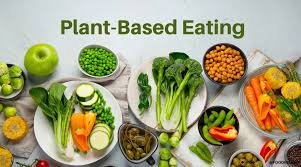The rise of plant-based eating in America is one of the biggest food trends in 2025. What started as a niche lifestyle choice has now become a major movement. More Americans are filling their plates with fruits vegetables grains and plant-based proteins than ever before.
This article explores why the rise of plant-based eating in America is happening the benefits driving it and what it means for the future of food health and the environment.
Why the Rise of Plant-Based Eating in America Is Happening

Several factors are fueling the plant-based boom across the country:
1. Health Consciousness
People are more aware than ever of the connection between food and health. Research shows that plant-based diets can lower the risk of heart disease diabetes cancer and obesity. In 2025 many Americans are choosing plants to boost their health energy and longevity.
2. Environmental Concerns
Plant-based eating is seen as a powerful way to fight climate change. Raising livestock uses a lot of land water and energy and it produces a lot of greenhouse gases. By eating more plants and less meat Americans are helping reduce their carbon footprints.
3. Animal Welfare

Many people are making food choices based on animal rights and ethical concerns. Avoiding or reducing animal products helps align their diets with their values.
4. Better Plant-Based Options
Gone are the days when plant-based eating meant bland salads and tofu. In 2025 grocery stores and restaurants offer a wide range of delicious plant-based meals from juicy burgers to cheesy pizzas all made without animal products.
How Big Brands Are Responding
The rise of plant-based eating in America has gotten the attention of major food companies. Brands like Beyond Meat Impossible Foods and Oatly have expanded their product lines while giants like McDonald’s Starbucks and Burger King now offer plant-based menu options nationwide.
Supermarkets are stocking more plant-based:
- Meat alternatives
- Dairy-free milks and cheeses
- Plant-based frozen meals
- Vegan snacks and desserts
Even fast food chains that once centered their menus around beef and chicken now proudly feature plant-based choices.
Plant-Based Eating in Everyday Life
Plant-based eating isn’t just for vegans anymore. Many Americans are identifying as flexitarians choosing to eat mostly plants but occasionally enjoying meat or dairy.
Flexitarian habits include:
- Meatless Mondays
- Choosing oat milk instead of cow’s milk
- Opting for plant-based burgers at cookouts
- Adding more vegetables and grains to meals
This flexible approach makes plant-based eating easier for more people to adopt without feeling restricted.
The Health Benefits of Plant-Based Eating
Studies continue to show that a well-planned plant-based diet can offer many health benefits:
- Lower blood pressure and cholesterol
- Reduced risk of heart disease and stroke
- Better weight management
- Improved gut health
- Lower risk of type 2 diabetes
- Stronger immune system
In 2025 doctors dietitians and health organizations are encouraging more Americans to shift toward plant-based diets for better long-term health.
The Impact on the Food Industry
The rise of plant-based eating in America is changing the food industry in big ways:
- New startups are creating innovative plant-based products.
- Farmers are growing more plant crops like chickpeas peas and lentils to meet demand.
- Food companies are investing heavily in research and development for better plant-based foods.
- Restaurants are creating exciting new plant-based menus to attract customers.
This shift is creating new jobs and opportunities across agriculture food manufacturing and retail.
Challenges of Plant-Based Eating
Even with all the excitement there are challenges to growing the plant-based movement:
- Cost: Some plant-based products can be more expensive than their traditional counterparts.
- Availability: In some rural areas plant-based options are still limited.
- Misinformation: Some people think plant-based diets are boring or nutritionally lacking which can slow adoption.
However education innovation and expanding availability are helping to overcome these hurdles.
The Future of Plant-Based Eating in America
Experts predict that the rise of plant-based eating in America will only continue to grow. Some trends to watch include:
- Cell-Based Meat: Lab-grown meat that does not require raising or killing animals could hit stores soon.
- Improved Plant Proteins: Companies are finding ways to make plant-based proteins taste and cook more like real meat.
- Sustainability Focus: Plant-based brands are working to make their production even more eco-friendly.
- Plant-Based Kids Menus: More schools and kid-friendly brands are offering plant-based options for younger generations.
Plant-based eating is moving from a trend to a lasting cultural shift that could redefine the American diet for generations to come.
How to Start Eating More Plant-Based
Thinking about joining the movement? Here are a few simple tips:
- Start with one plant-based meal a day.
- Try meat alternatives like lentil tacos or chickpea burgers.
- Swap dairy milk for almond oat or soy milk.
- Explore new vegetables grains and legumes.
- Experiment with global plant-based cuisines like Mediterranean Indian and Thai food.
You don’t have to be perfect to make a difference. Every plant-based meal helps your health and the planet.
Final Thoughts on the Rise of Plant-Based Eating in America
The rise of plant-based eating in America is transforming not just plates but lifestyles. Driven by health environmental awareness and better choices Americans are embracing a future that’s greener healthier and more compassionate.
In 2025 plant-based eating is more than a diet. It’s a movement that’s shaping the way America eats one plant-powered bite at a time.
Also read – Is Telehealth Here to Stay in the U.S. in 2025?






